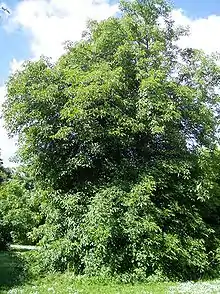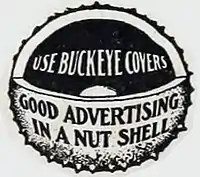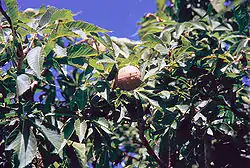Aesculus glabra
The tree species Aesculus glabra is commonly known as Ohio buckeye, American buckeye, or fetid buckeye. A. glabra is one of 13–19 species of Aesculus.
| Ohio buckeye | |
|---|---|
 | |
| Scientific classification | |
| Kingdom: | Plantae |
| Clade: | Tracheophytes |
| Clade: | Angiosperms |
| Clade: | Eudicots |
| Clade: | Rosids |
| Order: | Sapindales |
| Family: | Sapindaceae |
| Genus: | Aesculus |
| Species: | A. glabra |
| Binomial name | |
| Aesculus glabra | |
 | |
| Natural range | |
It is native primarily to the Midwestern and lower Great Plains regions of the United States, extending southeast into the Nashville Basin.[2] It is also found locally in the extreme southwest of Ontario, on Walpole Island in Lake St. Clair, and in isolated but large populations in the South (Adams County, Mississippi).[2] It is a medium-sized deciduous tree growing to 15 to 25 m (49 to 82 ft) tall.
The leaves are palmately compound with five 8–16 cm (3.1–6.3 in) long and broad. The flowers are produced in panicles in spring, red, yellow to yellow-green, each flower 2–3 cm (0.79–1.18 in) long with the stamens longer than the petals (unlike the related yellow buckeye, where the stamens are shorter than the petals). The fruit is a round capsule 4–5 cm (1.6–2.0 in) diameter, containing one nut-like seed, 2–3 cm (0.79–1.18 in) in diameter, brown with a whitish basal scar.
The inedible seeds contain tannic acid and are poisonous to both cattle and humans. The young foliage of the tree is also poisonous,[3][4] as is the whole plant to some degree.[5]
Symbolism and uses





The Ohio buckeye is the state tree of Ohio, and its name is an original term of endearment for the pioneers on the Ohio frontier, with specific association with William Henry Harrison. Capt. Daniel Davis[6] of the Ohio Company of Associates, under Gen. Rufus Putnam, traversed the wilderness in the spring of 1788, and began the settlement of Ohio. Davis was said to be the second man ashore at Point Harmar, on April 7, 1788. He declared later that he cut the first tree felled by a settler west of the Ohio River, a "buckeye" tree. Additionally, Colonel Ebenezer Sproat, another founder of that same pioneer city of Marietta, had a tall and commanding presence; he greatly impressed the local Indians, who in admiration dubbed him "Hetuck", meaning eye of the buck deer, or Big Buckeye.[7][8]
Subsequently, "buckeye" came to be used as the nickname and colloquial name for people from Ohio[9] and The Ohio State University's sports teams. Ohio State adopted "Buckeyes" officially as its nickname in 1950,[10] and it came to be applied to any student or graduate of the university.[11]
Native Americans blanched buckeye nuts, extracting the tannic acid for use in making leather. The nuts can also be dried, turning dark as they harden with exposure to the air, and strung into necklaces similar to those made from the kukui nut in Hawaii.[12]
Buckeye candy, made to resemble the tree's nut, is made by dipping a ball of peanut butter fudge in milk chocolate, leaving a circle of the peanut butter exposed.[13] These are a popular treat in Ohio, especially during the Christmas and college football seasons.[14][15]
Buckeyes (the nuts) are a recurring theme in Bill Watterson's comic, Calvin and Hobbes, often as one of Calvin's tools of torment.[16] Watterson himself grew up in Chagrin Falls, Ohio.[17]
References
- "Aesculus glabra". IUCN Red List of Threatened Species. 2019. 2019. Retrieved 17 June 2019.CS1 maint: ref=harv (link)
- "Aesculus glabra Range Map" (PDF). United States Geological Survey. Retrieved 2008-03-10.
- "Canadian Poisonous Plants Information System: Notes on poisoning: Aesculus glabra". Digir.agr.gc.ca. 2009-09-01. Archived from the original on 2012-02-20. Retrieved 2012-02-12.
- Encyclopaedia Britannica
- Elias, Thomas S.; Dykeman, Peter A. (2009) [1982]. Edible Wild Plants: A North American Field Guide to Over 200 Natural Foods. New York: Sterling. p. 272. ISBN 978-1-4027-6715-9. OCLC 244766414.
- Davis, George L. (1884) Samual Davis of Oxford MA and Joseph Davis of Dudley MA and their Descendants Press of Charles Hamilton, Worcestor, MA
- Hildreth, S. P. (1852) Early Pioneer Settlers of Ohio, H. W. Derby and Co., Cincinnati, Ohio, p. 237.
- Ohio Division of Forestry, Ohio…The Buckeye State, Ohio Department of Natural Resources brochure (rev 11/1998).
- "Archived copy" (PDF). Archived from the original (PDF) on 2008-04-28. Retrieved 2008-04-28.CS1 maint: archived copy as title (link)
- Walsh, Christopher (2009). Ohio State Football Football Huddleup, Triumph Books (Random House, Inc.), ISBN 978-1-60078-186-5, p. 120.
- "The Ohio State University Alumni Association". Retrieved 19 September 2020.
- Horton, Marcus. "Football: Ohio State-Michigan rivalry inspires longstanding devotion". The Lantern. Retrieved 19 September 2020.
- "Buckeyes". Food Network. Retrieved 19 September 2020.
- Campanelli, John. "PDQ's guide to the buckeye, just in time for the OSU-Michigan game". The Plain Dealer. Retrieved 19 September 2020.
- "The 10 Best Places For Chocolate Buckeye Lovers Around Ohio". Columbus Navigator. Retrieved 19 September 2020.
- "Calvin and Hobbes by Bill Watterson for December 14, 2009". GoComics. Retrieved 19 September 2020.
- Dietz, Cortni. "Northeast Ohio Native and Calvin and Hobbes Creator Bill Watterson Has Last Hurrah". Cleveland Scene. Retrieved 19 September 2020.
Further reading
- Darbyshire, S. J., & Oldham, M. J. (1985). "Ohio buckeye, Aesculus glabra, on Walpole Island, Lambton County, Ontario". Canad. Field-Nat. 99: 370–372.
- Farrar, J. R. (1995). "Ohio Buckeye". Trees in Canada. Fitzhenry & Whiteside Ltd. (Markham, Ontario) and the Canadian Forest Service (Ottawa). p. 157.
External links
| Wikimedia Commons has media related to Aesculus glabra. |
- National Register of Big Trees
- Aesculus glabra images at bioimages.vanderbilt.edu
- Ohio Buckeye Aesculus glabra Diagnostic photographs and documentation
- Winter ID pictures
- Interactive Distribution Map of Aesculus glabra
